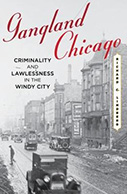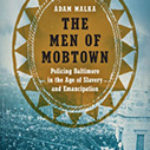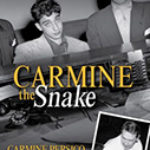Gangland Chicago: Criminality And Lawlessness In The Windy City

Author: Richard C. Lindberg
Publisher: Lanham, MD: Rowman and Littlefield, 2015. 404p.
Reviewer: Frederick T. Martens | July 2019
With the number of books written about Al Capone’s control of the Chicago underworld, I often wondered if there was any oxygen left for other criminal groups or gangs to exercise their entrepreneurial skills wrestling away a piece of what clearly was a very lucrative underground economy? Richard Lindberg accepted the challenge and has found that contrary to public perceptions of Capone’s all-consuming personality and presence, crime and corruption of an organized and systemic nature had captured the environs of Chicago as early as 1870—long before Capone came along.
In the academic community, Chicago has always been a fertile research environment for studying both disorganized and organized crime. From the research of Frederic Thrasher, John Landesco, Mark Haller, and Humbert Nelli to the Chicago School of Sociology, the cornucopia of ethnic groups that comprised the underground economy mimicked in virtually all respects, the powerful ward bosses and political figures that populated Chicago’s upper-world. In most cases, the two—-gangsters and politicians—were indistinguishable. And this was neither fortuitous nor accidental.
Lindberg’s treatment of this multi-cultural and multi-ethnic dynamic is both refreshingly illuminating but equally as sobering. Surely, the inter-ethnic rivalries, the political intrigue and internecine combat, and the social degradation heaped upon arriving immigrants provides a compelling history that in many respects, surpasses what we are witnessing today. Or does it?
Labeled “the wickedest city in America,” in 1859, Chicago’s tolerance of “liquor, vice, and the green cloth trade [gambling]” may “not extend back in time quite as far as New York’s criminal organizations, but with equal measure they engaged in the same brute force and thuggish behavior…” (pp. 15, 41-42).
Of course, the population of Chicago in 1860 was approximately 112,000 whereas New York City’s population cratered around 814,000—almost 8 times more. Indeed, an argument could be made that Chicago then and Chicago now was a much more violent and corrupt city when measured against New York City. In gang activity alone, the Department of Justice estimates that as many as 21,500 youth gangs comprised of 731,500 members are active in the Chicago. (p. xi) The number of murders in Chicago today, exceeds those of New York City and Los Angeles combined.
Lindberg’s treatment of the squalor and disenfranchisement that confronted newly-arrived immigrants provides a stark backdrop to the types and pervasiveness of crime that has continued to grip Chicago for over a century. “The segregation and isolation of the immigrant poor into decaying neighborhoods rife with saloons, gambling halls, bordellos, and jails progressed in the confident belief that bad boys will always ripen into hardened criminals. They were convinced that punishment and incarceration remained the best remedy to cure the contagion of crime. The festering attitude of benign indifference to reform movements helped spawn the gangs of Chicago and the poor crime districts they inhabited,” Lindberg concludes (p. 31).
As a welcomed reprieve from the litany of corrupt alliances that consumes Lindberg’s brutally-candid description of Chicago, he intermittingly discusses a number of reform movements that were enacted over the last several decades. Efforts to eradicate poverty-inflicted neighborhoods through urban renewal projects; creating neighborhood organizations to channel the most criminally-prone youth into legitimate opportunity structures; systemic reforms to the criminal court system, rescuing it from politically-controlled vessels into semblances of justice; and now introducing “interrupters” [former gang members who attempt to demonstrate the ills of careers in crime] were attempted but have met with underwhelming results (pp. xiii-xiv; p.111; p.118; p.178; p.311).
For reasons that are often part of America’s disjointed policy toward crime, we continue to witness the debate “pitting the advocates of harsh and unrelenting punishment against compassionate, liberal-minded proponents of community-based outreach programs…” (p. xv).
Circa “three strikes and you are out,” the “super-predator,” and “stop and frisk” equals mass incarceration. It seems the structure of the debate never changes, or when it does, impatience and imprudence making success fleeting!
Indeed, what would any historical recitation of crime in Chicago be if it did not confront the corrupt political system that has endured for decades, or more appropriately, a century or more? Perhaps the vilest of all crime but one that has become inculcated in what is called euphemistically, democracy.
Chicago’s blatant tribal or identity politics has managed to sustain itself through virtually every ethnic group that has traipsed across its “windy and lawless” landscape. Irish, Italians, Germans, Jews, Polish, Greeks, African-Americans, and Hispanics have all suffered in one way or another under the political oppression of “the Democratic [and Republican] bosses [who] courted the favor of underworld characters of the worst stripe…signal[ing] a willingness to exchange their street smarts, bullying tactics, and intimidation in return for guaranteed patronage jobs to dispense downward to the rest of the gang.” (p. 165). “Good and evil did not meet in a head on collision. They met only for the payoff, “as Lindberg so eloquently and succinctly put it.
“Politics was often interwoven with the rogue element of street gangs…The Irish gangs [of Bridgeport—a neighborhood in Chicago] of the late ninetieth century up through the Great Depression were more deeply engaged in the political process than their law-breaking counterparts in other areas of the city…six Chicago mayors…who controlled the city’s destiny for 130 years were born here…Whiskey Row was protected by a succession of Chicago mayors and influential politicians for over three decades,” according to Lindberg (pp. 35, 82).
New York may have had Tammany Hall, but Chicago’s government was owned lock, stock and barrel. In today’s vernacular, Chicago would have been referred to as a “failed state” or as Lindberg called it, a “gangster nation” — a government that was consumed by the nefarious elements who pillaged and exploited the most vulnerable communities.
Lindberg accepts and acknowledges the fact that these gangs were organized around the strong ethnic bonds that allowed for a sense of security and belonging among immigrant communities that were confronting what was often a hostile indigenous population. As he so candidly points out, “The three Feinberg brothers…took over leadership of the…. deposed Mortell-McGrath mob converting the ethnic identity of the gang from Irish-German to mostly Jewish (p. 135). “Two Irish gangs conducted a 24 hour reign of terror against the German, Jewish and Polish immigrants…calling themselves ‘the Mickies’” (p. 80).
Ethnicity was the glue that bound these criminal gangs together, making them in most cases impervious to any influences from the “righteously prim but fiercely bigoted” who attempted to enslave these newly-arriving immigrants (p. 10).
And of course, we now see the “rapid rise of the ‘new organized crime’…a by product of a lethal blend of alienation, societal neglect, murder, drug trafficking and decades of institutional racism prevalent within troubled African-American and Hispanic neighborhoods on the South and West sides” (p. x).
Not to be ignored in Lindberg’s kaleidoscope of organized crime is the role of Chicago’s Chinese community and it’s interaction with the “Outfit”— the Italian syndicate. “On both sides of Clark Street, down in gloomy basements or up in creaking stairways to lofts were opium joints, lottery offices and gaming resorts,” Lindberg reports (p. 69). “ By 1912, the population of Chinatown had swelled to five thousand…[a decision] was made to shift the Chinese settlement nearest to the city’s ‘badlands’…[after] the city’s father reasoned…[that] these people lost their souls through dope smuggling, prostitution, gambling and contract murder?” (p. 70).
Ultimately migrating to the North side of Chicago, the Chinese underworld confronted the realities of organized crime once it ventured outside of its close-knit community. “The “Chicago Outfit” muscled its way into the insular, but cash rich world of Chinese gambling, requiring…an $8000 a month ‘street tax’ to organized crime figures” (p. 73). Once again, “The Outfit” as it was known in Chicago, did what it always did best—extortion, the bread and butter of organized crime.
For those who wish to understand the folly of Prohibition, Lindberg’s examination and understanding of the vice rackets (i.e. sex, alcohol, gambling, and drugs) and how they fueled a succession of political machines reaching into the corridors of state and even the federal government provides a compelling but once again, a well-worn out admonition. “Prohibition made criminals out of otherwise law abiding citizens, and millionaires and political bosses out of criminals,” Lindberg opines. Without a doubt, “The bootlegging wars of the dry and lawless years mirror the carnage on the streets of Chicago today,” Lindberg believes (p. 254).
Insofar as Lindberg’s historical description of Chicago over the last century does not portend to be a clinical diagnosis of a city that for so many reasons never seemed to wrestle itself from its toxic tribal politics, he certainly provides the nascent researcher into both urban politics and organized crime with the grist to dissect the economic and sociological variables that have made Chicago resistant to systemic change. His intimate knowledge Chicago’s underground political economy is both an object and abject lesson for urban planners, community organizers, and government and political leaders.
Lindberg’s Chicago falls into the litany of ethnographic studies that have populated the many noteworthy studies of urban decay and revitalization. Organized crime and its attendant corruption provides a lubricant that for reasons well known but equally ignored, is not provided by the legitimate economy. “Necessity will always be the mother of invention.” The unwelcomed immigrant knew this all too well.
So, as you fly in or out of O’Hare International Airport on your next trip to or through Chicago, relish the fact that it is named after a World War II hero, Edward “Butch” O’Hare, whose father was Alphonse Capone’s attorney and partner.
Seeking an appointment to the United States Naval Academy for his son, the elder O’Hare was the government’s indispensable source for ending the brutal reign of Capone.
The O’Hare’s were symbolic of the “American Dream” and the “Immigrant Nightmare”. Both served their country in different ways. And both were killed “in the line of duty” (p. 253). One received the Medal of Honor and an airport named after him. The other a dastardly footnote in the annals of organized crime.
The O’Hare’s contribution to “Making America Great Again.”
Frederick T. Martens is the former President of the International Association for the Study of Organized Crime (IASOC). He has made a career of investigating organized crime in New York, New Jersey and Pennsylvania.


